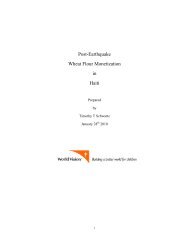Food Consumption Patterns Part 2
Create successful ePaper yourself
Turn your PDF publications into a flip-book with our unique Google optimized e-Paper software.
84<br />
10. Peanuts and Peanut Butter<br />
Almost every aspect of peanut production and consumption neatly touches on points mentioned in<br />
the previous sections. Peanuts are endemic to Haiti. Pre-Columbian Taino Indians planted them.<br />
Haitians have always planted them, and eaten peanut products as or more frequently than any other<br />
food that is not part of the main mid-day meal. Haitians prefer locally produced varieties over<br />
imported peanuts. The path to getting the peanuts is deeply embedded in the household and<br />
informal economies. In this penultimate section of the report we examine the peanut value chain,<br />
taste preferences, and consumption patterns with the goal of understanding how to best market<br />
peanut based RUTFs. In this regard, it is important to note that while informal markets and vendors<br />
are the prevailing source of foods for at least 80% of the population, the point of entry for most<br />
manufactured foods is the formal sector. The exception, as seen, are many Dominican imports<br />
which move in the opposite direction, from the Dominican formal industrial economy, to<br />
Dominican semi-formal economy intermediaries. The Dominican intermediaries then bring the<br />
goods across the border into the hands of informal economy Haitian traders, or the Haitians traders<br />
themselves cross the border and bring the food goods back, often on foot. But if RUTFs are to be<br />
produced in Haiti, production will be in the formal economy and the distribution entry point will<br />
be the formal sector market. Thus, section is meant to build on analyses in previous chapters and<br />
explore in greater detail how peanuts fit into the economy with the goal of defining, in the next<br />
and final chapter, how best to navigate RUTFs into the popular market without harming the local<br />
peanut value chain.<br />
The Peanut Value Chain<br />
Peanut products are currently part of an artisanal industry, and an important one. This industry is<br />
so important that we begin this section with a word of caution that entry into the market with<br />
peanut based RUTFs may intrude into the activities of impoverished market women. Roasted<br />
peanuts, peanut sugar clusters, chanm chanm, and peanut butter are all overwhelmingly local<br />
products: locally grown, locally processed, locally transported, and sold by low-income female<br />
traders.<br />
Peanut Production<br />
TechnoServe’s 2012 landmark peanut value chain report estimates that 35,000 households are<br />
involved in production, producing a total of 14,000 metric tons per year. Another 15,000<br />
households depend to some extent on the peanut value chain through the processing and marketing<br />
of roasted peanuts, peanut butter and other peanut products discussed below. The production<br />
occurs almost entirely on small farm plots, with each farmer cultivating an average .65 hectare in<br />
peanuts.<br />
We believe the TechnoServe estimates to be conservative. TechnoServe cites three primary peanut<br />
producing regions in Haiti. Using Port-au-Prince market sellers, they estimate the relative<br />
importance of the North at 7% of production, the Northeast at 8%, and the Central Plateau at 71%.<br />
However, significant quantities are grown in the South (based on common knowledge as well as<br />
Jolly and Prophete, 1999). And peanuts are produced at some level throughout the country. Even
















